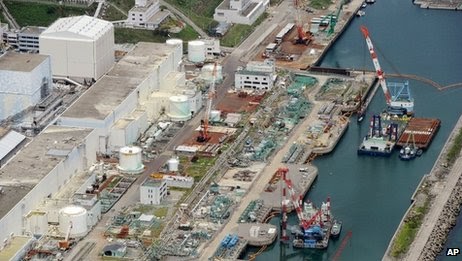20 August 2013 Last updated at 10:57 GMT
Fukushima nuclear plant: Radioactive water leak found
The tsunami knocked out cooling systems to the reactors at Fukushima
Radioactive water has leaked from a storage tank into
the ground at Japan's Fukushima plant, its operator says.
Tokyo Electric Power Company (Tepco) said the leak of
at least 300 tonnes of the highly radioactive water was discovered on Monday.
The plant, crippled by the earthquake and tsunami in
2011, has seen a series of water leaks and power failures.
The tsunami knocked out cooling systems to the
reactors, three of which melted down.
An employee discovered the leak on Monday morning,
Tepco said in a statement.
Officials described the leak as a level-one incident -
the lowest level - on the International Nuclear and Radiological Event Scale
(Ines), which measures nuclear events.
This is the first time that Japan has declared such an
event since the 2011 earthquake and tsunami, however.
Under the Ines, events have
seven categories starting with Level 0 ("without safety
significance") and Levels 1-3 denoting "incidents" while Levels
4-7 denote "accidents".
A puddle of the contaminated water was emitting 100
millisieverts an hour of radiation, Kyodo news agency said.
Masayuki Ono, general manager of Tepco, told Reuters
news agency: "One hundred millisieverts per hour is equivalent to the
limit for accumulated exposure over five years for nuclear workers; so it can
be said that we found a radiation level strong enough to give someone a
five-year dose of radiation within one hour."
More monitoring
A Tepco official told a press conference on Tuesday
that the water probably leaked from a tank after escaping a concrete barrier.
Workers were pumping out the puddle and the remaining
water in the tank and would be transferring it to other containers, Kyodo
added.
Water is being pumped into the reactors after cooling
systems were knocked out by the tsunami.
Hundreds of tanks were built to store the contaminated
water. Some of them had experienced similar leaks since 2012, but not on this
scale, a Tepco official said.
Tepco had been instructed to retrieve contaminated
soil and to strengthen monitoring of the surrounding environment, a regulatory
official told Agence-France Presse news agency.
No major changes in radiation levels outside the plant
had been observed so far, the official added.
The incident comes days after Tepco admitted that as
much as 300 tonnes of contaminated water a day was leaking from the damaged
reactor buildings to the sea.




